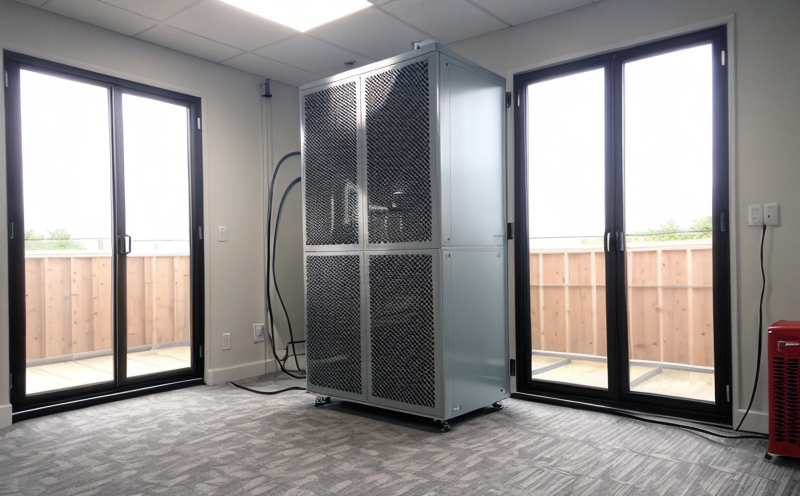ISO 14644-6 Cleanroom Airflow Balance Test
The ISO 14644-6 standard is designed to ensure that cleanrooms maintain the correct air balance, which is crucial for processes requiring specific particle and airflow conditions. This test evaluates the performance of a cleanroom by measuring its critical parameters such as pressure differentials, flow rates, and uniformity.
The process begins with thorough preparation of the cleanroom environment. All equipment must be in place and operational to ensure accurate measurement results. The testing phase involves placing sensors throughout the room to measure airflow, temperature, and humidity. These measurements are then compared against pre-determined standards set by ISO 14644-6.
The primary goal of this test is to ensure that each zone within the cleanroom maintains optimal air balance. This includes maintaining a specified pressure differential between adjacent zones to prevent contamination. The test also verifies that all required airflow rates are achieved and maintained, ensuring that critical processes can proceed without interruptions due to insufficient air supply or excessive drafts.
For R&D engineers involved in designing new facilities, this test provides invaluable data for optimizing cleanroom design. Compliance officers responsible for maintaining regulatory standards will find this service essential in meeting ISO 14644-6 requirements. Quality managers and procurement teams can leverage the results to ensure that only compliant equipment is used.
The ISO 14644-6 standard ensures that all cleanrooms are capable of sustaining precise air balance, which is critical for industries such as pharmaceuticals, electronics manufacturing, and biotechnology. The test's accuracy and reliability make it a cornerstone in the quality assurance framework for these sectors.
Benefits
- Ensure compliance with ISO 14644-6 standards to maintain cleanroom integrity.
- Identify and correct airflow imbalances that can affect product quality.
- Optimize cleanroom performance for higher efficiency and lower operating costs.
- Provide data for continuous improvement in facility design and operation.
- Avoid costly disruptions caused by unbalanced airflows during critical processes.
Quality and Reliability Assurance
The ISO 14644-6 Cleanroom Airflow Balance Test plays a pivotal role in quality management by providing quantifiable data that can be used to monitor and maintain the integrity of cleanrooms. This test is particularly important for industries where product quality is directly influenced by environmental conditions, such as pharmaceuticals and electronics.
By conducting this test at regular intervals, facilities can ensure that their cleanrooms meet the specified standards consistently. The data collected from these tests helps in identifying any deviations from expected parameters, allowing for timely corrective actions. This proactive approach not only enhances product quality but also minimizes risks associated with non-compliance.
For R&D teams, this service is an essential tool for validating new facility designs and operational procedures. By leveraging the results of these tests, they can make informed decisions that lead to more efficient and reliable cleanroom operations. Compliance officers will find this service invaluable in ensuring ongoing adherence to regulatory requirements, thereby protecting their organization's reputation and legal standing.
The reliability of the test results is further enhanced by using high-precision instruments calibrated according to international standards. This ensures consistent accuracy across multiple testing sessions. The data generated from these tests can be used as a benchmark for future improvements, contributing to long-term quality assurance efforts.
Environmental and Sustainability Contributions
The ISO 14644-6 Cleanroom Airflow Balance Test also contributes positively to environmental sustainability by promoting efficient resource usage. By ensuring that cleanrooms operate at optimal conditions, this test helps in reducing energy consumption and waste generation.
Inefficient airflow can lead to excessive heating or cooling needs, resulting in increased energy costs and higher carbon footprints. By balancing the airflows effectively as per ISO 14644-6 standards, facilities can minimize unnecessary resource use, thereby contributing to a more sustainable operational model.
The data collected during these tests can also be used to implement further environmental initiatives within the facility. For example, identifying areas where energy consumption can be reduced or waste can be minimized. This aligns with broader sustainability goals and demonstrates commitment to eco-friendly practices.
Moreover, the test results can inform decisions on upgrading equipment or processes that contribute positively to sustainability. By focusing on efficient air balance, facilities not only enhance their operational efficiency but also play a part in creating more sustainable environments for all stakeholders involved.





